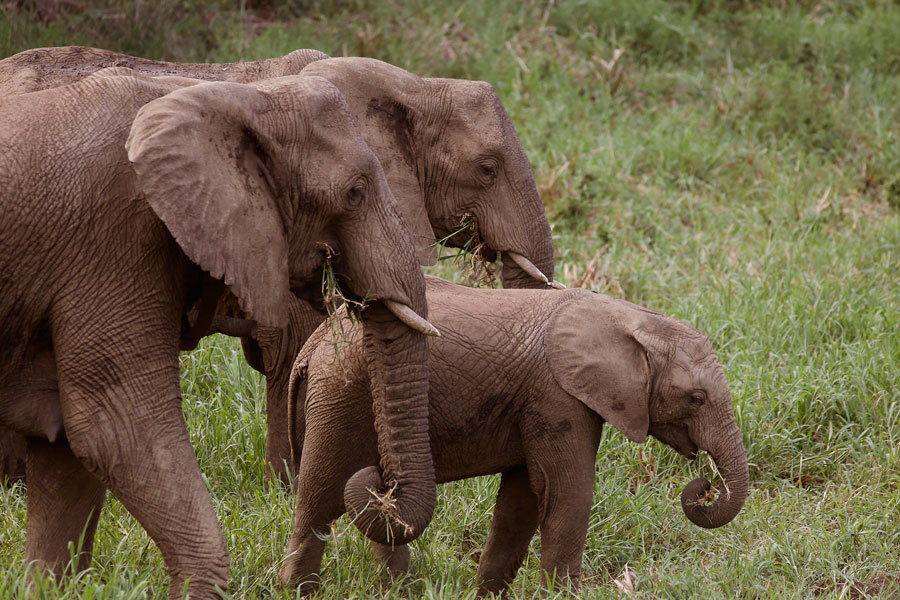Why Swaziland is putting 18 elephants on a Boeing 747
Loading...
Eighteen elephants are scheduled to board a Boeing 747 in Swaziland to fly to new homes in American zoos.
The elephants are to be distributed between three zoos: the Henry Doorly Zoo in Omaha, Neb., the Sedgwick County Zoo in Wichita, Kan. and the Dallas Zoo. In exchange for the animals, the zoos plan to contribute $450,000 to a wildlife conservation trust for rhinos in Swaziland.
The US Fish and Wildlife Service (FWS) approved the relocation last year, sparking outrage among conservationists. Four animal rights leaders from different organizations co-signed an objection letter to FWS in November, suggesting permit violations.
“It’s crazy, capturing wild animals and bringing them over here to put in zoos. It’s archaic, it’s not something that’s being done anymore and it shouldn’t be done,” Deborah Robinson, captive wildlife attorney and a co-signer of last year’s objection letter to the US FWS, tells The Christian Science Monitor in a phone interview Monday. “The zoos can’t keep their elephant populations up because they are dying twice as fast as they breed… There is no conservation about this move. These elephants will never be released; their babies will never be released. We are talking about bolstering the zoo population and nothing else.”
Elephants walk for almost 20 hours a day and require large open spaces for emotional and physical health, so captivity is never the best option for these large mammals, explains Ms. Robinson.
Officials at the three zoos insist they have the best intentions for the animals: the relocation saves the 18 elephants from poaching and culling, or intentional slaughter because the pachyderms are overcrowded in Swaziland.
Because the reserves care for the elephants so well, their populations have grown. And with Swaziland currently experiencing the worst drought in its history, there are simply too many elephants requiring too much water and food, park officials explain.
“With large appetites for vegetation and the power to easily take out trees and shrubs,” the elephants are destroying the habitat for other species, the Room for Rhinos campaign, a partnership between the three zoos, explains on their website. “18 elephants, 15 females and 3 males, must relocate to an new home, or be culled in order for Swaziland to meet its conservation goals of avoiding overpopulation and making room for rhinos.”
And not only would the relocation help these individual elephants, say zoo officials, but it will also help save Swaziland’s endangered rhino population.
“Wildlife experts believe the habitats currently decimated by the impact of a few dozen elephants have the potential to support hundreds of black and white rhinos, creating a significant opportunity to help a far more critically endangered species in Africa,” says Room for Rhinos. “Protecting large numbers of rhinos while saving the lives of elephants is a win-win scenario for conservation and animal welfare.”
“The plan to move them to the United States is a pragmatic and humane solution to help balance this environment and provide a home to elephants that need one, while at the same time expands a critically needed rhino conservation program,” Melissa Graham, a spokeswoman for the Kansas zoo, told The New York Times by email last week.
But elephant advocates don’t buy either of these arguments, Carney Anne Nasser, senior counsel for wildlife and regulatory affairs at the Animal Legal Defense Fund, tells The Monitor in a phone interview Monday.
“There is a serious conflict of interest here. The parties on both ends stand to profit,” argues Ms. Nasser. “The game park in Swaziland will get $450,000, and the zoos have already boasted how ticket sales will skyrocket once babies are born. It is about dollars and not conservation.”
And the rhinos don’t naturally live in this habitat, says Robinson. Instead, reserve officials are planning on moving the elephants out so they can move the rhinos in.
“Make a different space for the rhinos, you are moving them anyway,” argues Robinson. “You can’t choose one species over another. It just seems wrong to me to force elephants into captivity because you decided you want to focus on some other species.”
The Dallas Zoo, the Sedgwick County Zoo and the Henry Doorly Zoo could not be reached for comment.
“Regardless of whether it makes room for rhinos, there are a variety of options that don’t require selling the elephants for $450,000 to zoos and moving them to another continent,” says Nasser. Since the announcement, one reserve in Swaziland has said they could take the elephants if the reserves were serious about culling for space and resources.
“The zoos are always trying to raise money for conservation, saying they are for conservation areas, but at the same time they are giving out this message that elephants are safer in zoos,” Robinson says. “Extremely contradictory and untrue.”
[Editor's note: An earlier version misquoted Ms. Robinson.]








